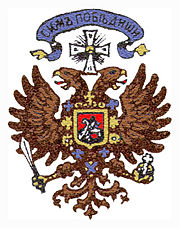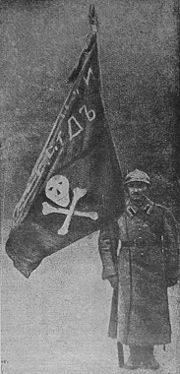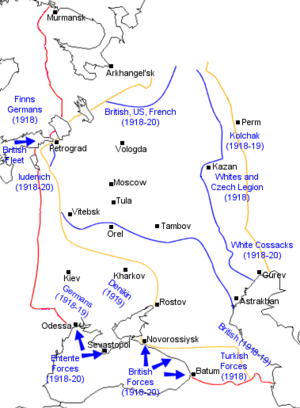White movement
| Armies of Russia |
|---|
|
Druzhina (862–1400s)
Streltsy (1400s–1721)
Army (1721–1917)
White Guard (1917–1921)
Red Army (1918–1991)
Army (1991–Present) |
The White movement (Beloie Dvijenie, Белое движение), whose military arm is known as the White Army (Belaia Armia, Белая Армия) or White Guard (Belaia Gvardia, Белая Гвардия, белогвардейцы) and whose members are known as Whites (Белые) or White Russians (a term that has other meanings) comprised some of the Russian forces, both political and military, which opposed the Bolsheviks after the October Revolution and fought against the Red Army during the Russian Civil War from 1917 to 1923.
Contents |
Structure and Ideology
The designation White has several interpretations. First, it stood in contradistinction to the Reds—the revolutionary Red Army who supported the soviets and Communism. Second, the word "white" had monarchist associations: historically the first monarch of unified Russia, Ivan III, was styled "Albus Rex", or "white tsar". Most importantly, some of the soldiers of White Army wore white uniforms of Imperial Russia.

Strictly speaking, no monolithic "White Army" existed; lacking central coordination, the White forces were never more than a loose confederation of counter-revolutionary forces. Besides considering themselves anti-Bolshevik Russian patriots, most White Army officers did not have a clearly articulated ideological vision. Among White Army leaders, neither General Kornilov nor General Denikin were monarchists. On the other hand, General Wrangel did have monarchist sympathies, but, as he made it clear, was willing to serve under a non-Bolshevik democratically elected Russian government. In any event, although many of its officers held monarchist ideas, it is inaccurate to state, as it is done sometimes, that the White Army was a monarchist army. It can be said, however, that the White Army as a whole generally believed in a united multinational Russia (being opposed to separatists who wanted to create nation-states in the place of the old Russian Empire).
The White Army also drew support from other political movements, including democrats, social revolutionaries, and others who opposed the October Revolution; at other times and in other places, the same groups supported the Red Army instead.
The rank-and-file troops of the White Army included both active opponents of the Bolsheviks (many Cossacks, for example), and spanned a variety of volunteers and conscripts, from nobles to peasants.
Some leaders of the White movement, particularly General Wrangel, formulated political concepts based on Russian traditionalism that were taken up and developed in emigre circles after the end of the Civil War by Russian thinkers such as Ivan Ilyin, who had many philosophical similarities with the Slavophiles. This became known as the "White Idea". It has been argued that the "White Idea" was in fact developed after the war, or simply was formulated after the war in a more doctrinal format. Not all White Army veterans were sympathetic to it, although virtually all organized veterans were (i.e., the Russian All-Military Union).


Monarchist tendencies reached a peak amidst the veterans of the White movement, while republicanism became rarer. The liberal policies of Alexander Kerensky and his socialist-democratic oriented provisional government were seen as largely responsible for preparing the country for the October Revolution. In August 1922, two months before its defeat, the far eastern White Army of General Mikhail Diterikhs went as far as to convene the Zemskiy Sobor of Preamursk, and elect (without his participation) Grand Duke Nikolai Nikolaievich Romanov as tsar of all Russia.
There were also independent groups such as the Green Army as well as the Black Army of Nestor Makhno, who declared themselves against both the Reds and Whites, although occasionally they sought alliances with one side or the other.
At times the Western Allies, the Central Powers, and other foreign forces provided assistance to several White Army units. This caused the Soviets to accuse the White Army of representing the interests of foreign powers.
Theaters of Operation

The Russian Civil War between Whites and Reds raged from November of 1917 until 1921, with isolated pockets of resistance continuing in the Far East until 1923. The White Army - with the occasional aid of Allied (and sometimes, Central Powers) forces from outside Russia (Japan, Britain, Canada, France, United States, Germany, Australia, including two who received the Victoria Cross for their actions against the Red Army - Greece & Czechoslovakia) held sway in some areas (especially Siberia, Ukraine and the Crimea) for periods of time and put considerable bodies of troops into the field. But they failed to unite or to co-operate effectively amongst themselves, and the Bolshevik Red Army eventually gained the upper hand.
The major theatres of the White armies can be grouped as follows:
- The Southern front: Started on November 15 1917 by General Mikhail Alekseev and commanded by General Lavr Kornilov, later headed by General Denikin and named the "Armed Forces of the South of Russia". This front had the most massive scale operations and overall posed the most serious threat to the Bolsheviks. In the beginning, it based itself entirely on volunteer support, a significant amount of it coming from the cossacks who were amidst the first to protest against Bolshevik rule. In 1919, after the Denikin offense on Moscow collapsed, the army was forced into a massive retreat. General Wrangel reorganized the army in Crimea, formed a provisional government (recognized by France), and began a new advance. It quickly failed when Polish leader Józef Piłsudski made a separate peace with the Soviets and withdrew Poland from the war.
- The Eastern (Siberian) front: Started in the spring of 1918 as an underground movement amidst army officers and right leaning socialist forces. The front began a major offensive in collaboration with the Czechoslovak Legions who were stuck in Siberia (local Bolshevik governments barred them from leaving Soviet Russia). Admiral Kolchak headed the resistance and a provisional Russian government. The army made significant advances in 1919, but was pushed back to the far east where it continued to resist up to October 1922.
- The Northern and North-Western fronts: Started immediately after the Bolshevik takeover by Pyotr Krasnov, then headed by General Yudenich, General Miller, Prince Anatoly Lieven, and others. These fronts had less coordination than the Southern Army of Denikin, including a few problematic adventurers such as General Bermont Avalov and General Bulakh Bulakhovich (the former declared war on neighboring Estonia). The most notable achievement was the attack on Petrograd, then the capital of Soviet Russia.
Post-Civil War
Considerable numbers of anti-Soviet Russians clustered in Belgrade, Berlin, Paris, Harbin, Istanbul, and Shanghai, setting up military and cultural networks, which lasted through World War II (for example, the Russian community in Harbin and Russian community in Shanghai). Thereafter White Russian activity found a new principal home in the United States.
In the 1920s and 30's, several White organizations were formed outside Russia with the intention of overthrowing the Soviet government through guerrilla warfare. These included the Russian All-Military Union, the Brotherhood of Russian Truth, and the National Alliance of Russian Solidarists.
Russian cadet corps were founded in several countries in order to prepare the next generation for the "spring campaign" (a term coined by white emigres meaning a hoped-for renewal of their campaign against the Bolsheviks). A significant number of these cadets volunteered for service in the Russian Corps during World War II, when many white Russians desired to participate in the Russian Liberation Movement.
Soviet historiography has tended to paint the Civil War as primarily a war of foreign intervention. White generals were stereotyped as monarchists who were bankrolled by foreign governments and business tycoons, wealthy Russian land owners, and the Russian Orthodox Church. The White army was portrayed as an army formed of people from the upper classes (the nobility) as well as forced peasant conscripts.
Prominent persons of the White movement
- Mikhail Vasilevich Alekseev
- Stanisław Bułak-Bałachowicz
- Pavel Bermondt-Avalov
- Anton Ivanovich Denikin
- Mikhail Gordeevich Drozdovsky
- Mikhail Diterikhs
- Alexander Ilyich Dutov
- Ivan Aleksandrovich Ilyin
- Aleksei Maksimovich Kaledin
- Vladimir Oskarovich Kappel
- Aleksandr Vasilevich Kolchak
- Lavr Georgevich Kornilov
- Pyotr Nikolayevich Krasnov
- Alexander Pavlovich Kutepov
- Anatoly Lieven
- Vyacheslav Grigoryevich Naumenko [1][2][3]
- Sergey Leonidovich Markov
- Vladimir Zinovyevich May-Mayevsky
- Evgenii Karlovich Miller
- Grand Duke Nicholas
- Viktor Leonidovich Pokrovsky
- Grigory Mikhailovich Semenov
- Andrei Grigoriyevich Shkuro
- Baron Roman von Ungern-Sternberg
- Ariadna Tyrkova-Williams
- Pyotr Nikolayevich Wrangel
- Nikolai Nikolaevich Yudenich
See also
- Volunteer Army
- Allied Intervention in the Russian Civil War
- White Emigre
- Don Army
- Russian All-Military Union
- Russian Corps
- Russian Liberation Movement
- Russian Liberation Army and the Committee for the Liberation of the Peoples of Russia
- Operation Keelhaul
- Basmachi Revolt
- The Betrayal of Cossacks
- Latvian Riflemen
- White-
- Estonian Freedom War